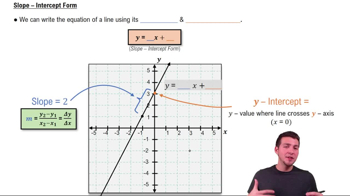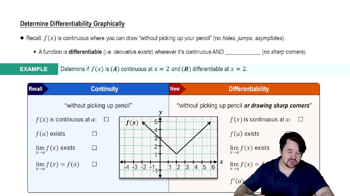Table of contents
- 0. Functions7h 52m
- Introduction to Functions16m
- Piecewise Functions10m
- Properties of Functions9m
- Common Functions1h 8m
- Transformations5m
- Combining Functions27m
- Exponent rules32m
- Exponential Functions28m
- Logarithmic Functions24m
- Properties of Logarithms34m
- Exponential & Logarithmic Equations35m
- Introduction to Trigonometric Functions38m
- Graphs of Trigonometric Functions44m
- Trigonometric Identities47m
- Inverse Trigonometric Functions48m
- 1. Limits and Continuity2h 2m
- 2. Intro to Derivatives1h 33m
- 3. Techniques of Differentiation3h 18m
- 4. Applications of Derivatives2h 38m
- 5. Graphical Applications of Derivatives6h 2m
- 6. Derivatives of Inverse, Exponential, & Logarithmic Functions2h 37m
- 7. Antiderivatives & Indefinite Integrals1h 26m
- 8. Definite Integrals4h 44m
- 9. Graphical Applications of Integrals2h 27m
- 10. Physics Applications of Integrals 2h 22m
0. Functions
Properties of Functions
Problem 3.2.45a
Textbook Question
Analyzing slopes Use the points A, B, C, D, and E in the following graphs to answer these questions. <IMAGE>
a. At which points is the slope of the curve negative?
 Verified step by step guidance
Verified step by step guidance1
Step 1: Understand that the slope of a curve at a point is determined by the derivative of the function at that point. A negative slope indicates that the function is decreasing at that point.
Step 2: Identify the points on the graph where the curve is sloping downwards as you move from left to right. These are the points where the slope is negative.
Step 3: Examine the graph visually or use the derivative function if available to determine the slope at each point A, B, C, D, and E.
Step 4: For each point, check if the tangent line to the curve at that point has a negative slope. This can be done by observing if the tangent line is angled downwards from left to right.
Step 5: List the points where the slope is negative based on your observations from the graph or calculations from the derivative.
 Verified video answer for a similar problem:
Verified video answer for a similar problem:This video solution was recommended by our tutors as helpful for the problem above
Video duration:
1mPlay a video:
Was this helpful?
Key Concepts
Here are the essential concepts you must grasp in order to answer the question correctly.
Slope of a Curve
The slope of a curve at a given point represents the rate of change of the function at that point. It is determined by the derivative of the function, which indicates how steeply the curve rises or falls. A positive slope means the curve is increasing, while a negative slope indicates it is decreasing.
Recommended video:

Summary of Curve Sketching
Negative Slope
A negative slope occurs when the curve descends as you move from left to right. This means that as the x-values increase, the y-values decrease. Identifying points with a negative slope is crucial for understanding where the function is decreasing, which can be visually assessed on a graph.
Recommended video:
Guided course

Slope-Intercept Form
Graphical Analysis
Graphical analysis involves examining the visual representation of a function to determine its characteristics, such as slope. By observing the curve's behavior at various points, one can identify intervals of increase and decrease, as well as specific points where the slope changes from positive to negative or vice versa.
Recommended video:

Determining Differentiability Graphically

 6:21m
6:21mWatch next
Master Properties of Functions with a bite sized video explanation from Nick
Start learningRelated Videos
Related Practice


